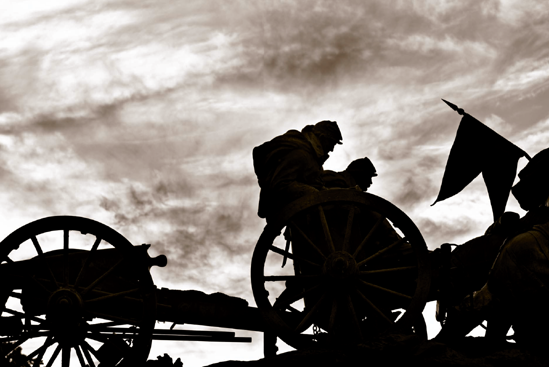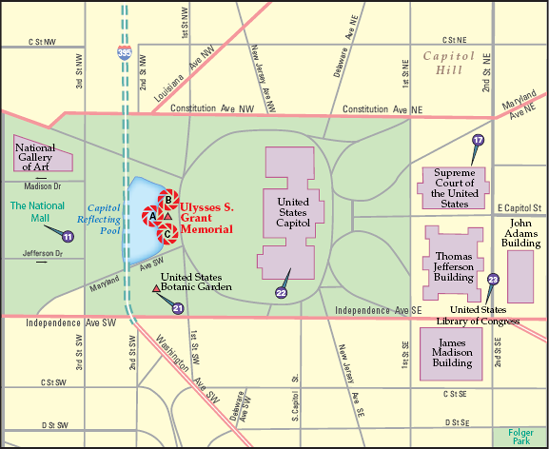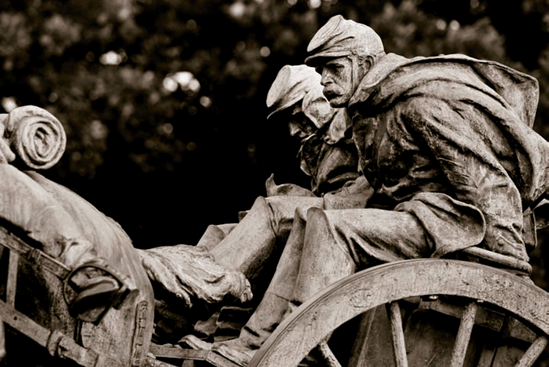
A silhouette of The Artillery Group, one of the statues of the Ulysses S. Grant Memorial. Taken at ISO 200, f/6.3, 1/500 second with a 130mm lens.
Before Ulysses S. Grant was the eighteenth president of the United States, he was the commander of the Union armies during the final years of the American Civil War. He is credited with the victory of the Union over the Confederacy.
The Ulysses S. Grant Memorial sits on the west side of the Capitol, and begins the west side of the National Mall. Grant is astride his favorite wartime horse, Cincinnati, and he looks out over the Mall to Abraham Lincoln, the president who sought Grant's tactical savvy and bravery to win the war over the Confederate Army. He is flanked by The Cavalry Group, in which he is a young commander leading a charge during the Civil War, and The Artillery Group, where soldiers are positioning for an impending battle.
Access to the Ulysses S. Grant Memorial is easy, because there is ample room to walk around the large statues.

Figure 19.1. The best locations from which to photograph the Ulysses S. Grant Memorial: (A) Grant and his wartime horse Cincinnati, (B) The Cavalry Group, and (C) The Artillery Group. Nearby photo ops: (11) National Mall, (17) Supreme Court of the United States, (21) United States Botanic Garden, (22) United States Capitol, (23) United States Library of Congress.
Grant and his horse can be photographed just next to the other statues, which allows you to use a longer lens and to use the sky behind the statue as a nice backdrop (see Figure 19.1).
Figure 19.2 can be done in a variety of ways; one method is to position yourself beneath the west side of the statue and shoot towards the sky. This simplifies the photo and gives the attention to the younger Grant, sword raised in the air, in command of his Union troops.
This statue, like The Cavalry Group, is full of amazing detail. Singling out a portion of the statue to photograph works well (see Figure 19.3), and again you have plenty of space on either side of the statue to position for a shot.

Figure 19.2. Ulysses S. Grant on his horse in the early evening (see A on the map). Taken at ISO 800, f/5, 1/320 second with a 90mm lens.
The light here is an important factor to getting a nice shot, but being prepared with the right gear always helps.
Telephoto lenses and nice light together can make great images here.
Keeping some distance between you and the statues here and using a longer lens helps to bring all the details of the statues together by compressing them — a trait of lenses 70mm and longer.
The first shot of Grant on his horse (refer to Figure 19.1) uses a 90mm lens, as does the image of The Calvary Group (refer to Figure 19.2). To get a clean perspective, The Artillery Group image was shot farther away and with a 230mm lens.
Using a polarizing filter when shooting perpendicular to the sun's light works well to darken blue skies and increase contrast between the clouds.
Unless you are photographing at night here, a tripod isn't necessary. It is, however, rather common to see tripods in use by photo enthusiasts in this area, especially on the west side of the Capitol Reflecting Pool for images of the U.S. Capitol at night and on the east side of the Ulysses S. Grant Memorial to get a photo of the Capitol. This specific area of the Capitol Reflecting Pool and Ulysses S. Grant Memorial is not managed by the U.S. Capitol Police, so within this area there's more leeway for tripods.
When photographing such statues, you definitely want to make sure that you have their essential elements in focus, but you also don't necessarily want the background in focus as well. So setting a reasonably low aperture value of between f/4 and f/8 helps to blur out the background while allowing enough light to enter your lens so that you can hand hold your camera without shaking it, which causes a blurry image. (Choose Aperture Priority mode to do so.) If you are photographing during normal light conditions, your camera's Automatic mode may work well, although you won't be able to necessarily control what the aperture is being set to.
Because the bronze of the statues has turned green, using a color balance that is too warm may mix with the green and blacks of the statues and create a warm, slightly muddy tone to the photo. If that is what you are seeing, try using the Daylight white balance, which is often cooler and reduces the yellows in the photo.
Also, adjusting your camera's exposure to compensate for either overly dark areas (by reducing exposure) or overly light areas (by increasing exposure) using your exposure compensation feature may be necessary, depending on your composition and the available light. If, for instance, you are doing a tight shot of The Cavalry Group and the dark, shaded trees are in the background, there's a good chance your image will come out overly bright and washed out because your camera's automatic exposure system thinks the scene is lighter than it really is. Reduce exposure by using the exposure compensation function to darken down your image. Very light scenes may come out too dark because the camera is trying to make them an average brightness. Increasing exposure helps those scenes retain the intended look.
Be especially attuned to the lighting conditions. Having the correct lighting helps you capture the look of the statue and its background accurately. The bronze statues of The Cavalry Group and The Artillery Group have oxidized quite a bit and are largely green as a result, but the statue of Grant on his horse seems to have escaped this to a degree. These can be photographed in color but are also great candidates to be rendered in black and white, especially when given a slight warm tone.
The Grant Memorial faces west, so evening is a nice time to photograph it. Evening light has less contrast and can help fill the dark spots of the statues with light. After the sun goes down, a nice glow comes from the Capitol Reflecting Pool and the area surrounding it. If the sun is high in the sky or behind the statues, there will often be overwhelming amounts of contrast which won't help the image. However, nice silhouettes are possible from either the east or west when the sun is lower in the sky.
Interesting cloud formations and skies work well for backgrounds to these statues. If it is foggy or raining, both can enhance the scene to a degree. Unique images have also been made when it's snowy — the abundant light reflecting from the ground helps to light the statues, and it also adds a feeling of intensity to the battle scenes.
There is little lighting at the Grant Memorial at night (usually just smaller lights near the statues on either side of Grant on his horse), although all sorts of indirect light come from areas just around it. It may require some experimentation, but night could work well to get some unique looks here.
In addition to trying black-and-white options, the green color of the bronze can be used to good effect with a nice blue sky. Also, you can experiment with compositions that layer different areas of the statues together as well as getting the Capitol or the Washington Monument in the shot.


